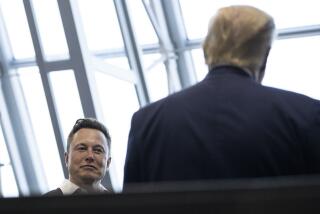Philanthropic Haas Family Embraces a New Cause--Total Control of Levi
- Share via
This city’s Haas family is as closely associated with philanthropy and social responsibility as the family-controlled Levi Strauss & Co. is linked with the denim blue jeans that its founder created more than a century ago.
To encourage literacy, for example, the Haas-owned Oakland A’s baseball team gives out free tickets to kids who sign “reading contracts” and fulfill them by reading 10 books.
During the 1950s, long before civil rights laws were enacted, the Haas family insisted that new plants built by Levi Strauss in the South be integrated; to this day, the company refuses to do business in South Africa.
Levi Strauss itself embraces a range of progressive charities and causes that most companies shy away from, from shelters for battered women to gay rights. The company donated $500 to the producers of “The Life and Times of Harvey Milk,” the Oscar-winning documentary that celebrated the life of San Francisco’s first openly homosexual supervisor, who was slain in 1978.
The company also pioneered in providing safe working conditions in an industry where sweatshops were the norm.
Received Recognition
It is little wonder, then, that Levi Strauss won the Lawrence A. Wien Prize for Social Responsibility from Columbia University last year, or that the Haas family won this year’s Alexis de Tocqueville Award for volunteerism from the United Way.
It should also come as no surprise that the Haas family would seek to portray its latest business venture--a proposal to convert Levi Strauss & Co. to private ownership through a $50-a-share leveraged buy-out--as the logical extension of a rich philanthropic tradition.
The buy-out, according to a filing made by family members with the Securities and Exchange Commission, would allow management to focus on the long term and “would be the most appropriate way to ensure that the company continues to respect and implement the important values and traditions of the company.”
Perhaps. But the proposed buy-out, which is being studied by an independent committee of Levi Strauss directors, is no bit of corporate philanthropy. Under the proposed transaction, family ownership in the company will jump to 92% from its current level of 40%. (The rest will be owned by non-family management and Hellman & Friedman, a San Francisco investment bank with close ties to the Haas family.)
Moreover, through the wonders of creative financing, family members won’t have to put any of their own money into the transaction. In fact, they’ll be able to pull about $340 million out of the deal.
“The Haases always take care of themselves first,” says a former Levi Strauss vice president. “This is a chance for them to own the whole company again, with very little risk.”
The risk in the deal will be borne primarily by a group led by San Francisco-based Wells Fargo Bank. It’s an appropriate pairing, for both Levi Strauss and Wells Fargo have prospered by trading heavily on their Western heritage.
The bank group will lend $1.45 billion for the acquisition and an additional $250 million in working capital. An additional $300 million will come from buyers of subordinated debt, to be underwritten by Salomon Bros.
In a commitment letter filed with the SEC, Salomon estimates that the interest rate on the debt will be between 14% and 14.5%. In other words, the Haases will be issuing the high-yielding “junk bonds” so popular in today’s mergers-and-acquisitions game.
Another plus for the Haases: They’ll no longer have to apologize for and endlessly explain poor financial results, as has been the case in the last several years with the slowing of the craze for basic blue jeans. Says one former Levi Strauss manager: “They can become a progressive version of the Bechtels,” the conservative, low-profile owners of a huge San Francisco-based engineering and construction empire.
Shareholder Sues
Does the fact that this looks like a good deal for the Haases mean that non-family shareholders are getting a bad one? Not necessarily, although one disgruntled shareholder has already filed suit, calling the transaction’s terms unfair.
In the short term, the deal is certainly a bonanza for non-family holders; Levi’s stock was trading in the mid-$30 range before the deal was announced earlier this month and sold for as little as $23 a share last year. It closed Friday on the New York Stock Exchange at $48.
Indeed, the $50-a-share price is sufficiently attractive to certain members of the Haas family that they plan to sell about 6.8 million of the family’s 14.8 million Levi Strauss shares to the new company that has been formed to facilitate the buy-out.
Family members will be allowed to take cash because “a lot of us, particularly older family members, had to make sure our estates would be liquid for tax purposes,” says Daniel E. Koshland Jr., professor of biochemistry at the University of California at Berkeley.
Koshland’s father, Daniel, was a cousin, in-law and close business associate of Walter Haas Sr. Together, they ran Levi Strauss from the 1920s to the 1950s.
Walter Sr.’s sons Peter and Walter Jr. took over in the 1950s and presided over Levi’s transformation into an international cultural phenomenon that made the company the world’s largest apparel maker. After a few years of non-family management, Walter Jr.’s son Robert D. Haas was named president and chief executive last year.
Can Hedge Bets
The provision allowing family holders to take cash will also allow them to hedge their bets. “This deal is a gamble for us,” Koshland explains. “Instead of being investors in a public company where you know exactly what you can get for your shares,” holdings in the new private company can’t be sold readily in the stock market. What’s more, the new company’s prospects will be less certain than the old one’s because the new company will be saddled with about $2 billion in new debt.
The family buy-out is the brainchild of Robert D. Haas, 43, a Harvard MBA and former Peace Corps volunteer. His yearlong stewardship has coincided with a period of painful contraction during which 23 plants were shut down and 6,500 workers let go.
The cutbacks helped Levi post an earnings gain of 165% in the first half of 1985 to $45.6 million, or $1.23 a share, even though sales were off 7% to $1.13 billion.
But the layoffs were handled as gracefully as possible. Workers were given generous severance pay and assistance in getting jobs elsewhere. Maternity benefits were promised to all pregnant women. In addition, Levi sought to minimize the impact of its departure on affected communities by pledging to continue charitable grants for up to three years.
“Social responsibility and philanthropy are deposits of a very special kind in the bank of public good will,” Robert Haas said in a recent speech.
Influence Society
“We can’t draw on that bank account for our own narrow self-interest, and our deposits won’t affect the bottom line in this quarter or the next. But they do something even more important--they influence the civility, fairness, decency and good health of our democratic society.”
That philosophy was borne out when Levi announced plant closings in Macon, Ga., and Denison, Tex. Assembled workers reportedly broke out in spontaneous applause when terms of the severance package were disclosed.
Such concern for employees’ welfare is a company tradition. When orders fell sharply during the Depression, Levi faced a choice of laying off 40% of its work force or putting all its employees on a three-day workweek. Walter Haas Sr. and Daniel Koshland put the issue up for a vote, and the workers overwhelmingly chose a three-day week.
The Haases were also behind the company’s move three years ago from a sterile concrete skyscraper to a low-rise, campus-like setting with a 1.9-acre plaza containing fountains, flowers, grass and trees.
Associates say Robert Haas, the leader of a new generation of Haases, is extremely intelligent--he was his class valedictorian at the University of California at Berkeley--and has a strong sense of family. In speeches, he reminds audiences that he is the great-great-grandnephew of Levi Strauss, the Bavarian immigrant who traveled to California in 1850 to make his fortune during the Gold Rush.
How Company Began
Landing in San Francisco with a roll of canvas that he planned to sell for tents and wagon tops, the 20-year-old Strauss ran into a miner. “You should have brought pants,” the miner is said to have told Strauss.
“Pants?” Strauss asked. “Why pants?”
“Pants don’t wear worth a hoot up in the diggin’s,” the miner replied. “Can’t get a pair strong enough to last.” So Strauss turned the canvas into pairs of pants tough enough to survive the rigors of the mining camps.
Strauss soon switched to a tough cotton fabric originally loomed in Nimes, France. The fabric was known as “serge de Nimes”--or denim, as it’s now called. Strauss added copper rivets to reinforce the pockets in the 1860s, patenting the idea in 1873.
Strauss, a bachelor, was something of a philanthropist himself, supporting orphanages and educational institutions. When the state Legislature created 28 perpetual scholarships at the University of California, Levi Strauss set up 28 of his own.
Strauss died in 1902 and left the business to his nephews. One nephew, Jacob Stern, ran the company until 1927; Stern’s daughter, Elise, married Walter Haas Sr. in 1914.
Rhoda Goldman, Walter Sr.’s daughter, says she was “weaned on social responsibility.” Koshland tells a similar story. Once, while on a trip to New York that featured outings to theaters and fine hotels and restaurants, his father took the three children to see New York’s poorest ghettos. “He wanted to underscore that we had a responsibility to those less fortunate than ourselves,” he recalls.
Goldman, who recently joined her brothers Peter and Walter Jr. on Levi Strauss & Co.’s board, says the decision to take the company private will ensure that the family will remain in control of Levi Strauss for the foreseeable future. “Over the years, family members have been selling off some shares, and the family’s ownership interest has been going down,” she says.
Adds Daniel Koshland: “The way things were going, it was pretty obvious that in a few years, the family might no longer have a decisive influence on the company.”
More to Read
Inside the business of entertainment
The Wide Shot brings you news, analysis and insights on everything from streaming wars to production — and what it all means for the future.
You may occasionally receive promotional content from the Los Angeles Times.










